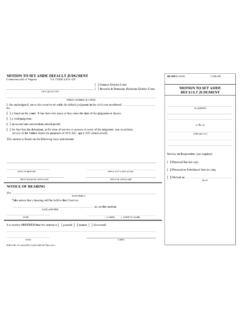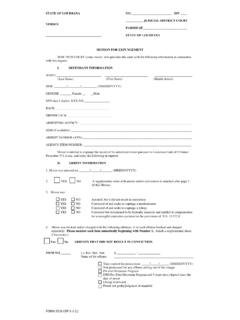Transcription of An Overview Of Subdivision Set-Aside Letters: Who, What ...
1 1 An Overview Of Subdivision Set-Aside Letters: Who, What, When, Where And Why by Rebecca S. Glos, Partner Watt, Tieder, Hoffar & Fitzgearld, * To Set-Aside Or Not? It is not uncommon, especially in today s economy, for a well-intentioned Subdivision developer to obtain the approved final tract maps from the governing local agency, arrange for competent contractors to work on the project, and procure the required performance and payment bond by a qualified surety only for the project to ultimately fail because of unforeseen financial difficulties. Once this occurs, the bond surety is often faced with: (1) a demand by the public agency (the obligee named under the performance bond) for the surety to complete whatever public improvements the principal/developer agreed to construct under a Subdivision improvement agreement; and (2) payment bond claims from subcontractors who provided labor and/or materials for the project, but have not been paid in full.
2 In addition to initiating an indemnity action against the principal and indemnitors bound by the general indemnity agreement, sureties can lessen the impact of such defaults by obtaining a Set-Aside agreement from the lender prior to agreeing to issue a bond on behalf of the developer/borrower. A Set-Aside agreement may take the form of a simple letter agreement from the lender to the surety. Alternatively, it may be a three-way agreement among the lender, the developer/borrower, and the surety. When available, these letters contain a promise, from the lender to the developer s surety, that the lender will Set-Aside a specific amount of funds, usually equal to the cost to complete the bonded improvements, out of the total amount being lent for the project, which will be paid to the developer/borrower (and/or its surety) for the performance of its work on the project.
3 A Set-Aside letter can create the necessary contractual relationship between the lender and the developer s surety, and provide that additional avenue for the recovery of payment. Convincing The Lender To Set-Aside While a lender s first response to a request for a Set-Aside letter is no, sureties can require that some assurance of payment is provided by the lender in order for the surety to issue the requested bonds. The incentive to the lender to issue such a Set-Aside letter is two-fold. First, without a surety agreeing to issue the required bonds, a Subdivision developer cannot begin construction and, thus, the likelihood of repayment under the loan is at risk.
4 Second, under the terms of the underlying construction loan, the construction lender may ultimately hold title to the property in question and, therefore, the lender can protect itself by being named as an additional obligee on the bond. In this instance, the surety will almost always require the lender to provide a Set-Aside agreement that obligates the 2 lender to make available certain funds for payment to the developer/surety, particularly if the developer defaults and the project is not completed. Creating A Sound Set-Aside letter The typical Set-Aside letter will include at least the following terms: (1) the total amount available from the lender for hard and soft construction costs; (2) a statement that the initial conditions precedent to the first funding of the loan have been fulfilled; (3) the general obligations of the lender to the developer/surety upon the developer s default; and (4) a requirement that the lender notify the surety if the developer defaults.
5 To make the most of the guaranties included in a Set-Aside letter , sureties should be aware of certain loopholes commonly relied upon by lenders to avoid honoring their obligations under a Set-Aside letter . To minimize these risks, a surety should consider the following provisions in any Set-Aside letter : Parties: Despite the fact that the principal/developer is the borrower named in the underlying loan agreement, the Set-Aside letter should name the surety as a beneficiary in addition to the borrower. This eliminates any objection from the lender that the only entity with standing to assert a claim under the letter is the borrower.
6 Amount: The maximum amount of the lender s commitment should be specified in the Set-Aside letter , and should match the total costs of construction. Further, the surety should be aware of phrases such as up to preceding the dollar amount, which may permit the lender to Set-Aside a lesser amount. General references to costs of construction may create the same ambiguities and loopholes for the lender to provide a lesser amount. Use of Funds: The agreement should describe the use to which the funds will be put, including any improvements that they are to cover. This reduces the possibility of the developer using the Set-Aside funds (intended to protect the surety in the event of a default) for any other purpose.
7 Disbursement Conditions: Further, the Set-Aside letter should ideally require the lender to administer the use of the funds so that they are only released for the purpose of constructing the bonded improvements. The Set-Aside letter should specify a set of conditions for those disbursements, including evidence of their use and that the project is lien free. Sureties should be aware, however, that few lenders will agree to taking on such a responsibility. Incorporation of Underlying Loan Agreement Terms: A lender may want to disburse the Set-Aside funds subject to the same conditions as are set forth in the underlying loan agreement.
8 This is because the underlying loan agreement, in all likelihood, contains a provision which allows the lender to cease making any disbursements in the event the borrower defaults. Nevertheless, as the surety is well aware, if a developer has defaulted on its loan, in all likelihood, it will also default on the bonded agreement, thus prompting the need for the surety to have access to the Set-Aside 3 funds in order to cure the developer s default. As such, unless there are no loan conditions which may hinder its ability to recover the Set-Aside funds, the surety should resist the incorporation of the loan agreement conditions into the Set-Aside letter .
9 More specifically, the surety should avoid agreeing to any term which would negate the lender s obligation to fund after any default under the loan agreement occurs. Recent Case Developments There are few published cases involving Set-Aside letters, and even fewer directly defining the scope of a lender s Set-Aside obligations. However, in the wake of the economic crisis and collapse of the real estate market, more cases are emerging, thereby providing insight as to how certain terms contained within Set-Aside letters may be interpreted by the courts and possibly enforced. In Lincoln General Insurance Co.
10 V. Tri Counties Bank, 2010 WL 3069874 ( Cal. August 5, 2010), the surety issued a Subdivision bond after relying upon the execution of a Set-Aside letter issued by the defendant construction lender. After the principal defaulted, the bank refused to release the remaining balance of the Set-Aside fund thereby prompting the surety to initiate an action for breach of contract and conversion. The lender moved to dismiss the complaint for failure to state a claim and argued that the set- aside letter was not a binding contract because neither the surety nor borrower signed it. The court denied the lender s motion and held that, because the lender had signed the letter and the surety s and borrower s actions (including, but not limited to, the issuance of the bond) signified their agreement, the Set-Aside letter was a binding agreement.









